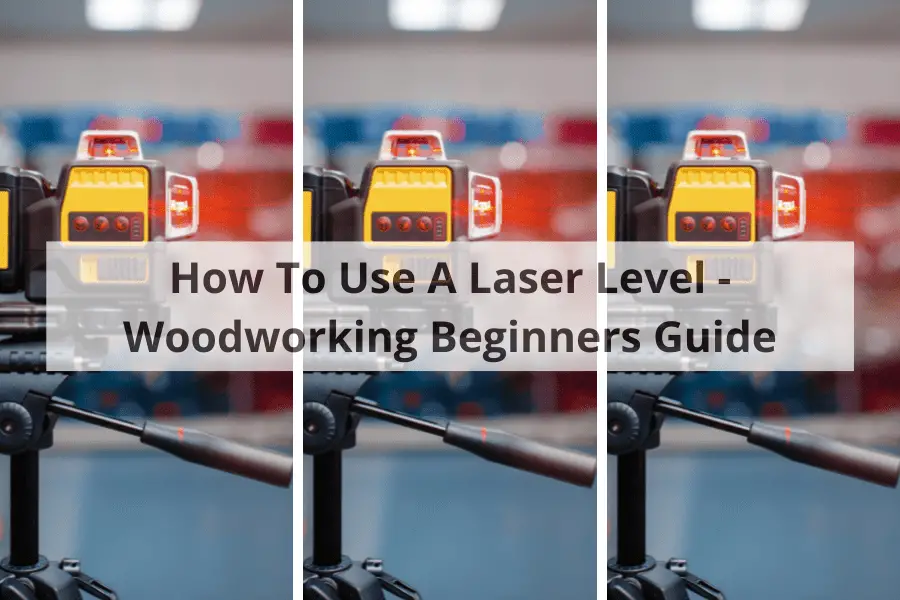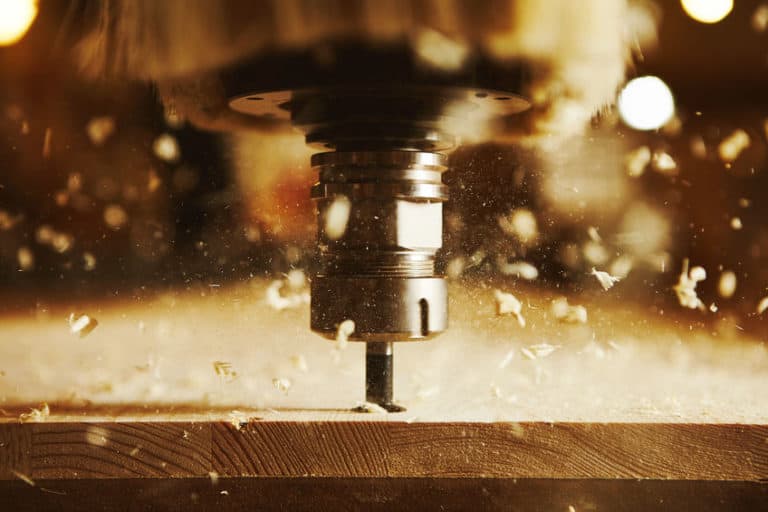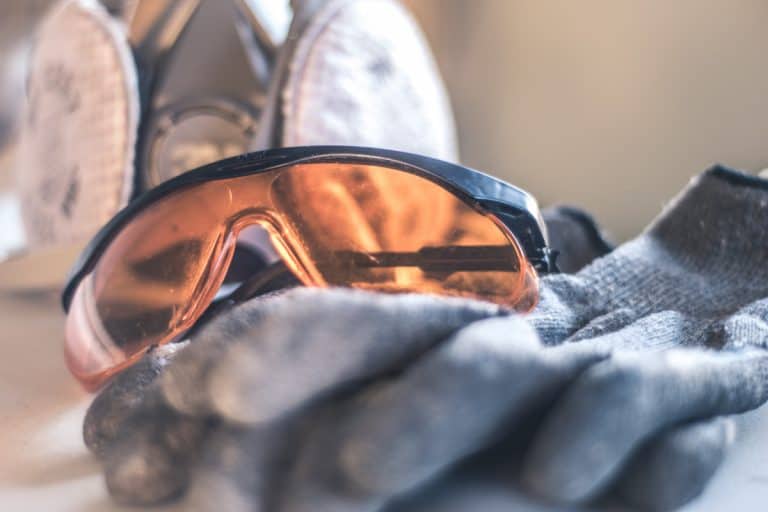
Laser levels are used in construction to place objects at a consistent height, such as wall studs or ceiling joists. They can also be used to scribe lines, transferring measurements from one surface to another (such as between an existing wall and a proposed foundation).
A laser level can also be used as a guide for cutting straight lines on plywood, drywall, and other wall or ceiling materials.
What Is A Laser Level?
A laser level, also known as simply a laser, is an electronic device used to indicate whether a surface is level by means of an optically-generated beam of light.
The laser level unit (laser plus base plate) is generally small enough to be carried in one hand; a larger laser level is mounted on tripods for stability. They can be used in many ways with woodworking, such as determining straight lines for cutting or also to see if a surface is level and more.
How Do You Use A Laser Level – For Beginners
When considering how to use a laser level you need to know how the laser level works. Typically, a laser level emits a single beam along the surface it is intended to measure. Reflections from this surface will cause the spot of light in the projected beam to shift laterally in either direction.
The amount of shift in each dimension is proportional to the distance the surface deviates from being perfectly horizontal or vertical, respectively.
If the beam is horizontal, a deviation from the level in the Y direction will cause the spot of light to move laterally back and forth along a vertical line.
If it is instead perfectly vertical, a deviation from the level in the X direction will cause the spot to move laterally along a horizontal line. In both cases, movement of the spot is an indication that the surface is not level.
The user may adjust the horizontal and vertical guides to suit whatever size targets are being measured. Typically, projected beams of the laser level will spread out slightly over long distances, which can be taken into account by adjusting the laser level beam width when marking objects at a distance.
To measure an extended target with one laser beam (for example, an entire room), the base plate can be mounted on a tripod and rotated as needed.
Types of Laser Levels And Accessories
Color Coded
Laser levels are often color-coded so the user knows which type of beam to expect from the device being used.
For example, if a red dot is projected instead of a single beam, the device is typically a rotary laser level (which uses one beam) instead of a line beam level (which projects two parallel beams).
Rotary laser levels sometimes come with additional features such as the ability to project triangular patterns or circles, or to work in combination with other tools like transit levels.
Rotary Lasers
They are more expensive than line beam lasers because rotating components are required in order to sweep the beam across the working surface.
They can be used with or without their mounting bases, which has given rise to an extensive range of accessories like rotary lasers on wheels and robotic devices that use them for continuous 3D scanning.
Johnson Level & Tool 99-006K Self Leveling Rotary Laser System Kit, Red, 1 Kit
Vertical Line Lasers
All vertical line lasers (which project parallel beams) are often used to align objects such as picture frames and other items on planar surfaces.
Vertical line lasers can also be combined with transit levels to project horizontal crosshairs over a target, making it easy to align the target’s location with existing features (such as walls and doorways).
Laser Detector – Laser Receiver
A laser detector or laser receiver is a handheld receiver that can be used to detect the position of a projected laser beam, even over long distances.
The ideology behind a laser detector is based on the fact that when a beam strikes a surface, it reflects some of the light back in the direction it came from.
The amount of reflected light detected by the laser detector is proportional to the surface roughness and how perpendicular the surface is to the beam.
A laser detector typically has a narrow field of view, so it must be swept across the area where the beam is expected to appear.
When the laser detector is lined up with the beam, it will produce an audible tone that gets louder as the unit.
Cross Line Laser
A cross-line laser is a type of rotary laser that projects not one, but two perpendicular beams. This makes it easier to level or align targets in both the horizontal and vertical planes simultaneously.
A cross-line laser is commonly used by carpenters, electricians, plumbers, and others who need to make quick work of leveling and
Laser Level, RockSeed 50 Feet Cross Line Laser with Self-Leveling, Vertical and Horizontal Line, Rotatable 360 Degree
Self-Leveling Laser Level
A self-leveling laser level is a type of rotary or line beam laser that contains an internal pendulum that automatically levels the device.
This is done by sensing when the laser is not level and then activating a motor that adjusts the position of the laser until it is level using a self-leveling mechanism.
Some self-leveling lasers also have the ability to project a plumb bob, which can be used to level objects in the vertical plane.
Self-leveling lasers are considered the most accurate and easy-to-use type of laser level.
How To Use A Laser Level For Shelves
A laser level is a tool that uses lasers to ensure objects are laid out at the correct height. The device projects two beams of light: one vertical and one horizontal on a flat surface.
When both lines meet, they reflect to form a crosshair. By using them on shelves, for example, you can make sure each shelf rests at the right height and is even on a flat surface.
Ensure objects are laid out at the correct height. The device projects two beams of light: one vertical and one horizontal.
When both lines meet, they reflect to form a crosshair. By using them on shelves, for example, you can make sure each shelf rests at the right height and is even.
1 – Get your laser level. Make sure it’s a vertical laser line level because the beams need to be parallel. The two horizontal laser line beams should be at a 90-degree angle from each other, and the one vertical beam should be perpendicular to them.
If you do not see the beam from the laser level you may need to use a laser detector.
2 – Decide which side of the shelf will be against the wall and which side will be free.
3 – Place the laser level on the side of the shelf that will be against the wall and align it with one end of the shelf. Make sure that it’s placed securely, as opposed to just sitting on top of the box.
4 – Press down on one end of your tape measure and hold it along the bottom of the laser level. Make sure that the end of your tape measure is touching the wall.
You want to make sure that no part of it hangs over the edge, as this will throw off your measurements.
5 – Press down on the other end of your tape measure and hold it along the top of the shelf. This should make a crosshair with the laser beam, so long as it’s lined up exactly.
You can double-check this by placing the level on top of the shelf and aligning them both.
6 – Repeat steps 2 to 5 at each spot along with your tape measure until you get to the other side of your wall.
7 – Finish placing your shelves. Remember to place one against the wall and one that’s free.
How To Use A Laser Level To Hang Pictures
A laser level is a tool that uses lasers to ensure objects are laid out at the correct height. The device projects two beams of light: one vertical and one horizontal.
When both lines meet, they reflect to form a crosshair. By using them on shelves, for example, you can make sure each picture rests at the right height and is even.
1 – Get your laser level. Make sure it’s a vertical line level because the beams need to be parallel. The two horizontal beams should be at a 90-degree angle from each other, and the one vertical beam should be perpendicular to them.
If you do not see the beam from the laser level you may need to use a laser detector.
2 – Decide which side of the box will be against the wall and which side will be free.
3 – Place the laser level on the side of the box that will be against the wall and align it with one end of the box. Make sure that it’s placed securely, as opposed to just sitting on top of the box.
4 – Press down on one end of your tape measure and hold it along the bottom of the laser level. Make sure that the end of your tape measure is touching the wall.
You want to make sure that no part of it hangs over the edge, as this will throw off your measurements.
5 – Press down on the other end of your tape measure and hold it along the top of the box. This should make a crosshair with the laser beam, so long as it’s lined up exactly. You can double-check this by placing the level on top of the box and aligning them both.
6 – Repeat steps 2 to 5 at each spot along with your tape measure until you get to the other side of your wall.
7 – Finish placing your pictures. Remember to place one against the wall and one that’s free.
Frequently Asked Questions
Are Laser levels And Tape Measures Different
Yes and no. The main difference is that a laser level requires batteries while a tape measure relies on millimeters or meters. A laser level uses a laser beam and a bracket to make sure that objects are even, whereas a tape measure uses an end hook to mark the spot. Both tools are used for hanging shelves or other wall decorations.
Are Laser Levels Safe
Laser levels are incredibly safe. They have beams that will not harm you when they’re off, but they are powerful enough to burn your eyes out if you stare into the lenses. They are made with warning labels that say not to look into them. You can use them without worrying about hurting your eyes or damaging your surroundings.
Are Laser Levels Hard To Use
Laser levels are complicated at first, but once you get the hang of it, they’re easy to use. You can adjust the settings on certain models, such as making sure that you get the right angle when using it. These levels are good for hanging anything from small lamps up to large paintings and mirrors.
How Do You Use A Laser Tape Measure
To use a laser tape measure, first push the on switch and allow it to warm up (it will automatically shut off after 10 minutes if you do not use it). Then, select the side of the tape you want to have to be the zero point by pressing up or down. Finally, hold one end of the tape on an object and walk until you get a reading from the laser.







